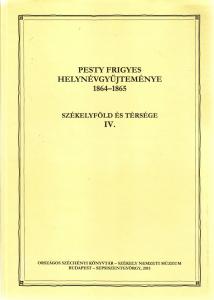
Frigyes Pesty’s Collection of Toponyms 1864–1865. Volume IV.
Frigyes Pesty’s Collection of Toponyms 1864–1865. Volume IV.
Szeklerland and its Region
Complementary Volume
Published by Árpád Csáki
NSZL–Szekler National Museum, Budapest–Sepsiszentgyörgy, 2015., 247 pages
ISBN 978 963 200 647 5
Frigyes Pesty’s collection of toponyms of 1864-1865 that covered the entire territory of the Hungary and Transylvania of his time was purchased from the scholar’s widow by the Hungarian National Museum in 1890. During the 1960’s, the entire material was copied to microfilm at National Széchényi Library that was part of the Museum, and would later become an independent entity. From the very beginning, researchers have made use of the data and descriptions of this collection, like Balázs Orbán did regarding Szeklerland.
The purpose of this publication is to make available the data collected by Frigyes Pesty of the Eastern bloc of Transylvania with Hungarian ethnic majority (historical Szeklerland and the related Hungarian majority settlements), and the South-Transylvanian Hungarian settlements most researchable from there. Consequently, as for historical Szeklerland, we publish the entire material (mostly in Hungarian, and partly in Romanian) but as for the neighboring regions, we limit ourselves to the reports submitted in Hungarian language.
It was the spring of 1864 when Frigyes Pesty sent out to the local authorities the mandate and the printed questionnaire of nine points of the Transylvanian Gubernium. The reports thereafter received vary in terms of content, extent and the senders’ personality. They were usually written by local magistrates based upon the memories of the elderly, the traditions and the old documents of their place. Questions on history generally were not answered by settlements where there had been a population swap. Descendants of the Szeklers of the military or free citizen order usually highlighted their Szekler or even Hun descendance. In the reports, toponyms were given special emphasis, being the names of lanes (dűlő) the most frequently provided. Responders with more local knowledge also provided smaller toponyms within the lanes.
The content of the present volume is made up by the reports on 22 settlements of the historical Aranyosszék, the Hungarian settlements of the counties Alsó-Fehér (87), Torda (55), Felső-Fehér (17), and Küküllő (6), and the single settlement Romoszhely in the Saxon administrative unit Szászvárosszék (Scaunul Orăştiei/Brooser Stuhl). According to the present administrative division, the settlements described belong to the counties Brassó/Braşov (4) Fehér/Alba (131), Hunyad/Hunedoara (5), Kolozs/Cluj (44), Maros/Mureş (3) and Szeben/Sibiu (23).
Shopping
Our publications are available in our bookshop, or can be ordered from the Publications Department of the NSZL using the contact details below: Főigazgatói Kabinet kiadványtára, Országos Széchényi Könyvtár, 1276 Budapest P.O. box 1205., phone: 06 1 232-3556, e-mail: kiadvanytar@oszk.hu.




